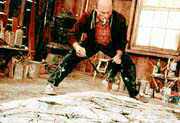Directed by Ed Harris; starring Ed Harris, Marcia Gay Harden, Amy Madigan, Jennifer Connelly, Bud Cort, John Heard, Val Kilmer and Jeffrey Tambor.
Based on the biography Jackson Pollock: An American Saga by Seven Naifeh and Gregory White Smith, Ed Harris makes his directorial debut with a lovingly crafted, if slightly lacking, portrait of the famous and often infamous abstract expressionist.
Pollock begins with a quick peek at Jackson Pollock during the height of his success – a female fan approaches him at an opening and asks him to autograph a copy of a Life magazine feature on his work. We are then quickly transported back to 1941, when Pollock was a young and tormented artist living with his brother and sister-in-law in a small Greenwich Village walk-up.
Enter Lee Krasner (brilliantly brought to life by Marcia Gay Harden), a contemporary painter curious about Pollock’s work. The two artists quickly become lovers and eventually marry. But their relationship, as depicted in the film, seems to be based more on its own weird brand of co-dependency than on love or desire. (Perhaps an even more interesting film would be one that focuses on Krasner and why she basically abandoned her own career to promote her husband’s.)
Initially, Krasner galvanizes Pollock’s career by introducing him to the eccentric art patron Peggy Guggenheim (Amy Madigan). As the film progresses and the artists age, Krasner continues to coddle and encourage her husband. Within the context of the film, it’s hard to imagine that Jackson Pollock would have been Jackson Pollock without Lee Krasner acting as his biggest advocate. And supporting him wasn’t always an easy task. Despite a brief period of sobriety while living in Long Island, Pollock was a miserable, manic-depressive alcoholic. And he was also a genius. While Harris successfully depicts and performs Pollock’s dichotomous persona, he never offers any meaningful insight – beyond the conventional story of an angst-ridden alcoholic – into the artist’s behavior or his relationship with Krasner.
The best scenes of the film simply – and not so simply – capture Harris, as Pollock, in the act of painting. Early in the film, Guggenheim commissions Pollock to paint a mural for her town house. After a brief spell of artist’s block, we watch as Pollock sweeps the paint onto the canvas in simultaneously impulsive and intuitive strokes. Later, when Pollock discovers his signature splatter, we once again get to witness his method of creation. Pollock’s process, like his product, manages to be both intellectual and visceral. And while we may walk way from the movie knowing little about the artist’s inner life, Harris’s successful recreations of Pollock’s act of painting make it a journey well worth taking.
